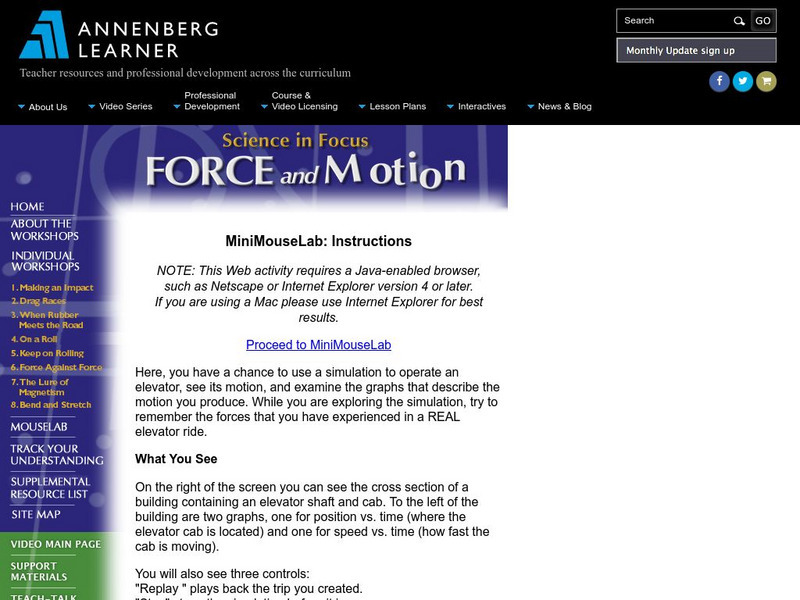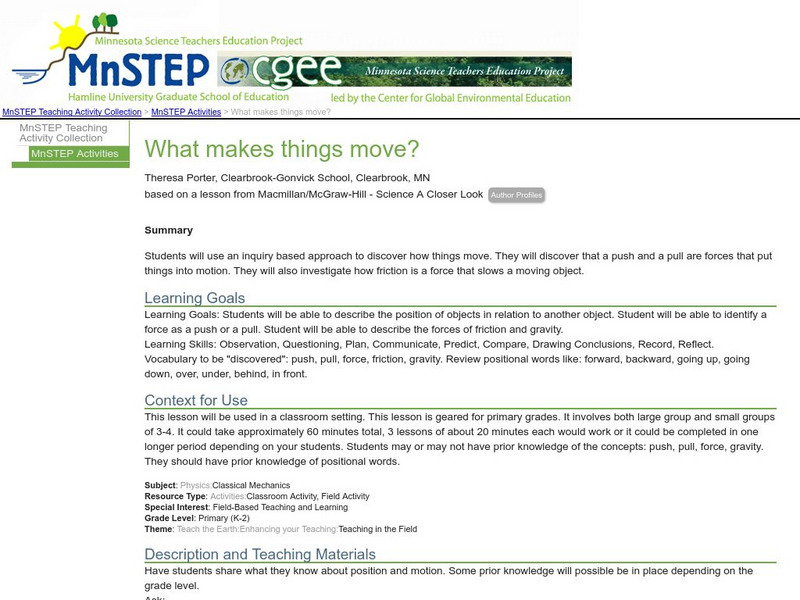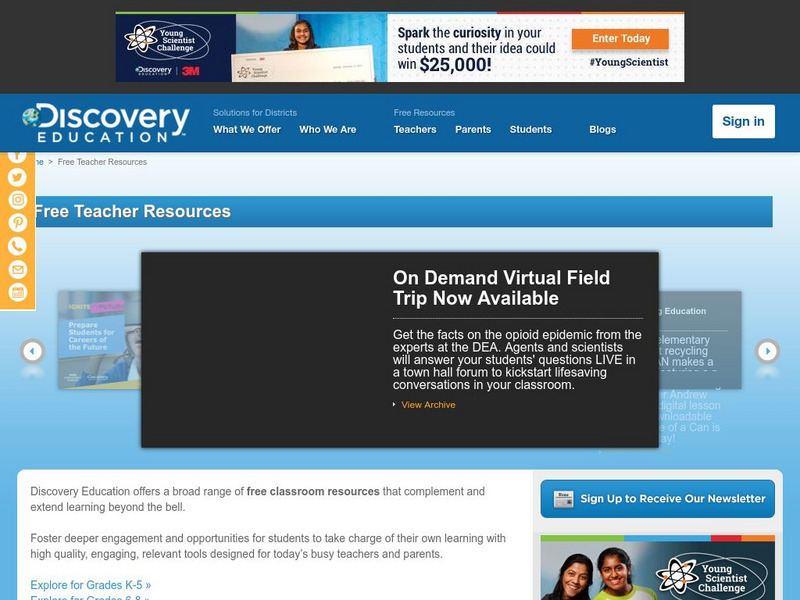Annenberg Foundation
Annenberg Learner: Mini Mouse Lab
Use a simulation to operate an elevator and see its motion. Examine the graphs that describe the motion you produce.
Annenberg Foundation
Annenberg Learner: Amusement Park Physics: Roller Coaster
This interesting and interactive exhibit demonstrates how Newton's Laws of Motion impact the design and safety of roller coasters.
Other
Center for Education Partnerships: The Marble Roll
In this Science-athon, students try to make their marble roll the farthest across a flat surface, using their knowledge of forces, motion, and energy to guide them through their apparatus design. Teachers must enroll online.
E-learning for Kids
E Learning for Kids: Science: Seychelles: What Is a Force?
Cody the tour guide is learning about forces on the island. Try to help him learn about pushing and pulling.
Science Education Resource Center at Carleton College
Serc: Exploring Acceleration Through Vectors
The goal of this activity is to get students to think about what is happening when velocity and acceleration vectors point in different directions. The pictures, sentences, and cars used allow the students to picture each situation in...
Science Education Resource Center at Carleton College
Serc: Hanging Out With Galileo
Students isolate the factors that determine the period of a pendulum, and then test their hypotheses to determine if their experimental results come close to the mathematical results.
Science Education Resource Center at Carleton College
Serc: Mn Step: What Makes Things Move?
In this activity, students will learn about push and pull forces that make things move. They will also practice using position words to describe location. To learn about forces, they will move objects, observe the movement of objects and...
Exploratorium
Exploratorium: Science Snacks: Marshmallow Puff Tube
An engineering design process project where you will try different lengths of cardboard tubes to see how far you can blow a marshmallow. Project uses Newton's principles of unbalanced force to shoot the marshmallow far.
Discovery Education
Discovery Education: Friction in Our Lives
Students observe objects in motion down a ramp to discover how the force of friction affects an object's motion. Includes the lesson plan, vocabulary list, and extensions for students.
Discovery Education
Discovery Education: Physical Science: Gravity Gets You Down
In this lesson, students make predictions about falling objects of different sizes and masses to learn about gravity and air resistance. Includes audio vocabulary list and extension activities.
Physics Aviary
Physics Aviary: Practice Problems: Atwood Machine Problem
Students must find out the time it takes a mass on an Atwood Machine to fall a certain distance.
Physics Aviary
Physics Aviary: Practice Problems: Newton's Law System (No Friction)
Students must find out different things for a series of objects moving as a system.
Physics Classroom
The Physics Classroom: Newton's Second Law of Motion
Learn more about finding acceleration through the practices found in this lesson. "The process of determining the acceleration of an object demands that the mass and the net force are known." Check out this comprehensive site.
Physics Classroom
The Physics Classroom: Waves and Sound: Slinky Lab Interactive
Manipulate this virtual slinky that consists of a collection of dots to represent its coils. Grab a coil, and shake it back and forth to create vibrations which travel through the slinky from the location where it is shook to the ends...
Physics Classroom
The Physics Classroom: 1 D Kinematics: Ticker Tape Diagrams
Learn how to perform a ticker tape analysis as a way to analyze the motion of an object.
Physics Classroom
The Physics Classroom: Momentum and Its Conservation: Momentum
Through examples and interactive practice problems, students explore the momentum equation.
Physics Classroom
The Physics Classroom: Work, Energy, and Power: Application/practice Questions
Through illustrated examples and practice problems, students apply the relationship between work and mechanical energy change to a variety of motion scenarios in order to test our understanding.
Physics Classroom
The Physics Classroom: 1 D Kinematics: Acceleration vs. Constant Velocity
Observe the animation of the three cars. Use the animation to answer three questions about their acceleration and velocity.
Physics Classroom
The Physics Classroom: Vectors and Projectiles: The Plane and the Package
Consider a plane moving with a constant speed at an elevated height above the Earth's surface. In the course of its flight, the plane drops a package from its luggage compartment. This animation depicts such a situation. The path of the...
Physics Classroom
The Physics Classroom: Vectors and Projectiles: The Truck and the Ball
Imagine a pickup truck moving with a constant speed along a city street. In the course of its motion, a ball is projected straight upwards by a launcher located in the bed of the truck (with no air resistance). This animation depicts the...
Physics Classroom
The Physics Classroom: Momentum and Collisions: The Astronaut Catch
Students imagine that they are hovering next to the space shuttle in earth-orbit, and bump into another astronaut of equal mass. If the two astronauts holds onto each other, then how fast do they move after the collision?
Physics Classroom
The Physics Classroom: Momentum/collisions: Diesel Engine and Flatcar Collision
This animation portrays the inelastic collision between a very massive diesel and a less massive flatcar. After the collision, both move together with the same velocity. Students can figure out the after-collision velocity of the two...
Physics Classroom
The Physics Classroom: Momentum and Collisions: The Cart and the Brick Part A
An animation that portrays the collision between a 3.0-kg loaded cart and a 2-kg dropped brick. It will be assumed that there are no net external forces acting upon the two objects involved in the collision. The only net force acting...
Physics Classroom
The Physics Classroom: Momentum and Collisions: Big Fish Catches Little Fish
This animation portrays the inelastic collision between a very massive fish and a less massive fish. What is the after-collision velocity of the two fish?










